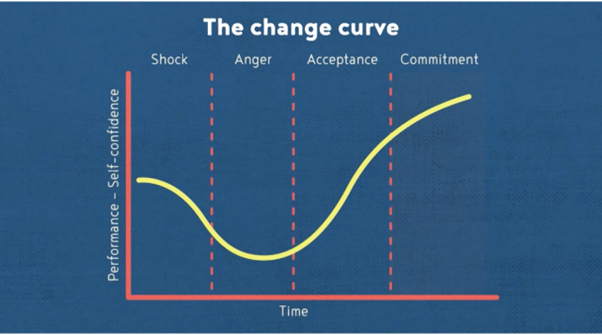
How do I support my team through change?
The transition curve is a popular model used to describe a person’s journey or transition through change. It helps you to predict how people may react to change, so you can support them on that transition. When change is first introduced at work, the people affected will typically go through four stages. These can be visualised on the change curve.
The stages are shock, anger, acceptance and commitment (however, it is worth gauging this first in your conversation, as not everyone has these reactions).

People’s initial reaction to the change will likely be shock or denial as they refuse to accept that change is happening.
Once the reality sinks in and people accept the change is happening, they tend to react negatively. They may feel angry or fearful and actively resist or protest against the changes. This is perfectly understandable, as that person may have been an expert in the way things used to be done and their expertise has resulted in respect. The coming change undermines this position.
If people continue to resist change and remain at stage 2, the change will never work, at least for the people who react in this way. So you need to help them move out of this stressful and unpleasant stage, into the more positive, acceptance stage.
At stage 3, people stop focusing on what they’ve lost and start to let go and accept the change. People will begin to test and explore what the changes mean to them.
When people reach the last stage, commitment, they not only accept the changes, but embrace them. They then start to restructure their ways of working and become more productive and positive.
From the University
- A good first step is to explore the situation with the colleague in more depth using the Workplace Pressures Risk Assessment (WPRA) tool (see here for a step-by-step guide). This should be completed sensitively and privately, allowing the colleague to share their perception of work-related concerns openly with you.
- ACAS Tips to approach having sensitive conversations 2018 is a helpful guide to refer before you begin.
- The Dealing with Change and Uncertainty web page links to People Development training courses and resources (for individuals and managers), internal services and NHS advice.
- Our Employee Assistance Programme, Spectrum Life offers 24/7 confidential, in-the-moment support, advice, and counselling for mild-moderate mental health issues (if clinically appropriate), as well as a life-coaching service.
- It is important to complete a Wellbeing Impact Assessment available via Equality Impact Analysis when planning any change
Contact
| occupationalhealth@exeter.ac.uk |
colleaguewellbeing@exeter.ac.uk |
| hradvisors@exeter.ac.uk |
peopledevelopment@exeter.ac.uk |
